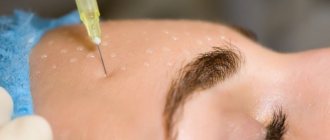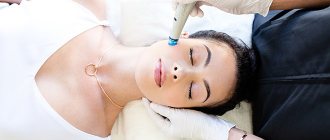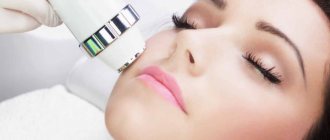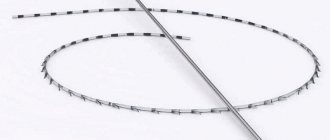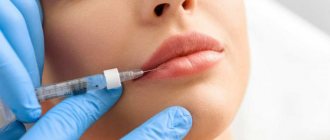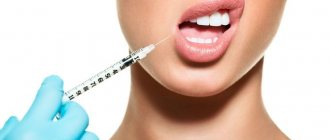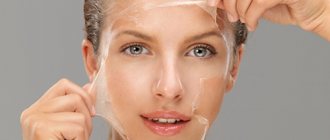Mechanism of action
To understand the essence of the technique and appreciate the scientific work done by thousands of specialists, you need to remember a little (and for some, discover) something from histology - the science of tissues. The fact is that 2 types of connective tissue are responsible for the elasticity and smoothness of our skin - collagen and elastin. The gaps between the fibers are filled with hyaluronic acid.
Over time, due to many external and internal factors, collagen and elastin fibers become less and less, or they are present in sufficient quantities, but their structure is disrupted. The amount of natural “cement” - hyaluronic acid - also decreases. Because of this, wrinkles appear on the skin, it becomes flabby and uneven.
With the help of bioreparation, it has become possible to restore the required volume of hyaluronic acid and even - drum roll - to launch the natural processes of internal regeneration of the skin. One session of this procedure is enough to improve the appearance of the skin, and if you decide to take the full course, you will delight your loved ones with your blooming appearance and a second youth. How is this possible?
During bioreparation, certain preparations containing hyaluronic acid, vitamins, proteins and amino acids are introduced using intradermal microinjections. This multicomponent nature makes it possible to create a depot of substances necessary for the skin in the treated area. But this is not the only advantage of the technique - the long-term presence of the drug components (more than 14 days) in the dermis triggers natural regeneration processes that continue to work after the “storehouses” are depleted.
How does bioreparation work?
Structural proteins - collagen and elastin - are responsible for the elasticity of the skin; they maintain youth and prevent sagging tissue. The connecting element between them is hyaluronic acid; it attracts and holds water molecules. With age, the number of structural proteins either decreases or the connection between them is lost. As a result, wrinkles appear and dermal tissue becomes dry and flabby.
In this case, bioreparation will come to the rescue. Hyaluronic acid (HA) saturates cells with moisture, additional components nourish the skin. The advantage of the method is the long-lasting effect. Typically, hyaluronic acid is destroyed after a few days by the enzyme hyaluronidase.
Bioremediation preparations use a modified version of HA, which is not sensitive to the action of enzymes. The substance remains stable for 3 weeks. During this time, the processes of self-renewal and rejuvenation are launched in the skin. Peptides, microelements, and amino acids are attached to the chains of hyaluronic acid. They provide a long-lasting and lasting effect.
After the procedure, positive changes occur:
KK Adapt. 5 paragraph
- elasticity returns;
- improves complexion;
- the relief is normalized;
- scars dissolve;
- vascular permeability improves;
- fat breakdown occurs;
- local immunity increases.
Biorevitalization and bioreparation - is there a difference?
Bioreparation is the next stage in the evolution of biorevitalization. Both procedures are similar in the technique of implementation - microinjections of certain drugs into one of the skin layers. The key difference between the methods lies in the composition of the input agents and, accordingly, in their action.
Biorevitalizants contain only hyaluronic acid, which can be in a stabilized or unstabilized state. A relative disadvantage of such drugs is their short stay in the dermis - up to 72 hours. Therefore, the effect of biorevitalization does not last so long.
Bioreparants are complex preparations based on the same hyaluronic acid. But a significant addition to these products are peptides, vitamin complexes, and amino acids. Thanks to this multicomponent nature and special molecular structure, bioreparation preparations can remain in the skin for up to 3 weeks, creating a supply of nutrients and stimulating the synthesis of new collagen fibers.
One such drug is Hyalrepair. Its uniqueness lies in the solid-phase modification method, which made it possible to attach additional active substances to the hyaluronic acid molecule. Thanks to this degeneration, the Hyalripier molecule is not exposed to hyaluronidases, enzymes that break down hyaluronic acid.
While the drug is in the dermis (about 21 days), fibroblasts are stimulated - cells that are responsible for the synthesis of connective tissue fibers, including collagen. Additionally, Hyalripayer has a powerful antioxidant effect on all layers of the skin, increasing its protective properties and activating regeneration processes.
So what is better – bioreparation or biorevitalization
If you want to get a long-term effect, but you don’t have time to visit a beauty salon often, bioreparation is your choice. For those who decide for the first time to undergo intradermal injection of hyaluronic acid, it is better to focus on biorevitalization.
The patient underwent 3 bioreparation sessions
Advantages and disadvantages
The procedure is an invention of Russian cosmetologists.
The main advantage of this operation is the use of innovative drugs :
- Hyalrepair (Hyalripayer);
- Meso Wharton (Mezovarton);
- Meso Xanthin (Mesoxanthin).
All of them differ in the composition of additional elements and are used for different age categories.
Often used are products from the Hyalrepair line (02, 04 and 08) .
In addition to hyaluronic acid, they contain cysteine, proline, vitamin C and B, glutathione, glycine, L-carnitine, lysine. They help moisturize and whiten the skin, even out its color and structure, strengthen blood vessels, and tighten the contours of the face.
Injections of these drugs are safe , they have almost no side effects, and are highly effective. Used for patients over 30 years of age.
Mesovarton contains a polypeptide that promotes the division and growth of stem cells in the epidermis, restores fibroblasts, renews and strengthens the deep layers of the skin.
Suitable for age group from 45 to 65 years. Mesoxanthin consists of a large number of components: regulatory peptides, vitamins C, A, E, fucoxanthin, nucleic acids and amino acids, antioxidants.
This drug slows down cell aging, renews and restores the skin. Indicated for young patients over 25 years of age.
Advantages:
- long action;
- high efficiency;
- lack of recovery period;
- painlessness;
- wide range of indications;
- the result is visible after the first procedure.
Flaws:
- possibility of allergic reactions;
- multicomponent drugs create a load on the body;
- high price.
Bioreparation has a very powerful effect, it is better to resort to it for people over 35-40 years old.
Indications for use
List of indications:
- Dry skin, increased sensitivity.
- Ptosis is the drooping of one or another area of the face.
- Photoaging: the presence of dryness and hyperpigmentation, rosacea.
- Chronoaging: facial wrinkles, decreased tone and elasticity.
- Acne.
- Scars.
- The process of skin rehabilitation after aggressive rejuvenation techniques (use of laser, burns after various procedures).
- Flabbiness of the skin of the hands.
- Presence of cellulite.
- Stretch marks after sudden weight loss.
Preparations for facial bioreparation
The photo shows the drug VIVIFY Rejuvenating Soft Filler for facial bioreparation
The first drug for facial bioreparation was invented in Russia. Its trials at the RAS hospital and the Sechenov Moscow Medical Academy were completed in 2009. The product is called Gialripayer. It is completely free of chemical agents and is made from raw materials sourced from Japan and Europe.
The Russian manufacturer offers several varieties of the drug. Today products 02, 04, 05, 06, 07, 08, 10 are produced. Each number is focused on obtaining a specific result and differs in composition. For example, 02 contains hyaluronic acid, vitamin C and amino acids. It successfully fights scars, wrinkles, and dry skin. Number 08 is enriched with carnitine, used for “deformation” type of aging, moisturizes the deep layers of the dermis, breaks down subcutaneous fat. The average cost of a drug for bioreparation is about 10,000 rubles.
Over time, foreign drugs began to appear, which are presented on the modern market in a wide variety:
- KHARIZMA (France) . The brand represents many drugs. The most popular Bio Revitalift (with hyaluronic acid, peptides, vitamins and amino acids), KHARIZMA Ultra (with coenzyme and vitamins), KHARIZMA Light and KHARIZMA Forte (contain a lower concentration of hyaluronic acid compared to the previous product). The average cost is from 5 to 9 thousand rubles.
- VIVIFY Rejuvenating Soft Filler ( Korea ) . The drug is intended for people over 45 years of age. It contains 24 amino acids, 3 peptides, 14 vitamins, 8 coenzymes and minerals. The product activates cells, promotes collagen production, and protects the epidermis from the effects of free radicals and ultraviolet rays. The cost of 5 ml of the drug is 5 thousand rubles.
- Dermaren lumi 10.0 (Korea) . A product based on polydeoxyribonucleotides and hyaluronic acid. It affects DNA at the intercellular level, moisturizes the skin, gives it tone, smoothes out fine wrinkles. The average price of the drug is 6 thousand rubles.
- Aquashine . The drug is produced by the South Korean holding CAREGEN. The product contains vitamins, amino acids, hyaluronic and nucleic acids, oligopeptides. The purpose of the funds depends on the type of the latter. The price ranges from 5 to 12 thousand rubles. depending on the composition.
- Mixyal Density (Switzerland) . The benefit of bioreparation using this product is to eliminate fine wrinkles in the area around the eyes, post-acne, and violations of the protective function of the epidermis. In addition to hyaluronic acid, it contains aspartic acid, minerals, amino acids, DNA nucleotide, and vitamins. The cost of a 5 ml meso cocktail starts from 1,500 rubles.
- Revita Derm . The French bioreparant contains sodium sulfate and amino acids. It is intended to eliminate the consequences of surgical operations, unsuccessful peeling, rejuvenation of aging skin, and for bioreparation under the eyes.
Important! The choice of drug is made by a cosmetologist after examining the patient and taking into account contraindications. Self-administration of medications may result in side effects.
Stages
Stages of implementation:
- As mentioned above, skin bioreparation is the introduction of a certain drug into the dermal layer using injections. Injections are felt differently by each person: for one it is just an unpleasant manipulation, for another it is quite painful. To make bioreparation as comfortable as possible, an anesthetic cream or gel is applied to the problem area before it begins. The anesthetic is applied to the treated area at least 3 times, and the exposure is maintained for 25 minutes. Some salons use needles so thin that no anesthesia is administered.
- When the skin has lost sensitivity, it is disinfected with a 0.5% chlorhexidine solution and the administration of the drug begins. The face, neck, and décolleté are treated using the “papule” technology. The needle is inserted into the tissue with the cut up and at a minimal angle, the drug is injected until a papule measuring 1-2 mm is formed (in the eye area - no more than 1 mm). If bioreparation of the face is carried out, then injections are made along massage lines at a distance of 1 cm. The neck is treated in parallel along arcuate lines, the distance between punctures is 1.5 cm. The décolleté area is injected along V-shaped lines in “steps” of 2 cm.
- After bioreparation is completed, the affected area is lubricated with a special cream, which has a calming effect and enhances regeneration. Puncture marks disappear within a day. To make the effect of the procedure more pronounced and last as long as possible, cosmetologists recommend using cosmetics that have a lymphatic drainage and lipolytic effect.
To achieve the maximum effect from bioreparation, you must complete a course consisting of 3 sessions (1 session every 3 weeks). It is also recommended to carry out a maintenance procedure – once every two months.
Watch a video about bioreparation:
Contraindications to the bioreparation procedure
Despite the fact that bioreparation of the neck and face is an aesthetic procedure, it has a number of significant contraindications. To avoid side effects, they should be taken into account.
It is prohibited to carry out bioreparation in the following cases:
- individual intolerance to the components of the drug;
- diabetes;
- skin infectious diseases;
- epilepsy;
- During pregnancy and breastfeeding;
- oncology, tumor;
- impaired blood clotting;
- acute viral and bacterial infections accompanied by fever;
- autoimmune diseases.
If contraindications are not taken into account, the effect after bioreparation may be reversed and even lead to complications.
Questions and answers
- Question: What is more effective: bioreparation or biorevitalization? Answer: The bioreparation procedure has a more pronounced and lasting effect. This occurs due to the multicomponent structure of the biorepair molecule, as well as the specific modification of hyaluronic acid.
- Question: Which is better to choose: bioreparation or mesotherapy with hyaluronic acid? Answer: The fact is that both of these procedures have a similar end result - the delivery of hyaluronic acid to the skin. But mesotherapy uses liquid solutions that contain 0.5-1% hyaluronic acid. In this case, you will need a course of at least 6 sessions. For bioreparation, preparations with a hyaluronic acid concentration of 3% are used, the course duration is 3 sessions.
Cosmetologists recommend mesotherapy for young girls; ladies over 35 are better off opting for bioreparation, as the method activates recovery processes and gives a powerful impetus to launching their own and natural regeneration of the skin.
Read alternative procedures on our website:
- Bio-reinforcement of the face
- Contour plastic
- Mesothreads
- Plasmolifting
- Thread lift
Possible complications, consequences
If you follow all the instructions and recommendations of a specialist, then there will be no negative consequences after this operation.
Bioreparation is well tolerated , but, like any cosmetic procedure, it can sometimes cause complications:
- mild swelling;
- painful sensations (very rare);
- inflammation at injection sites (papules);
- itching, slight redness;
- allergy to the components of the drug (rare);
- small hematomas (only with severe skin sensitivity).
Such side effects may appear a couple of hours after the injection and disappear without a trace within 2-3 days.
On our portal you will learn about another popular rejuvenation technique - facial mesotherapy, which will solve many skin problems and remove age-related changes!
On this page you will find a lot of interesting information about plasma lifting, the advantages of this method of rejuvenation and the technique of its implementation.
Have you heard about mesothreads for face lifting? What types of 3D threads are there, reviews and photos with results can be found here: .
Results of facial bioreparation
If you look at photos of patients before and after bioreparation, you will notice how the skin has smoothed out, small wrinkles have disappeared, large wrinkles are less noticeable. The tone of the face is evened out, acne and scars disappear, the skin tightens and becomes elastic. The effect lasts from six months to a year.
Often the result is noticeable after 1-2 procedures. But sometimes it happens that injections are made, but there is no effect. This factor indicates the individual characteristics of the dermis. Don't worry: after a course of sessions, the result will definitely appear.
Price
The procedure is not cheap, because multicomponent drugs are used to carry it out. The price depends on the drug used and ranges from 10,000 to 18,500 rubles. The cost of the procedure is indicated in Moscow.
In other cities the price may be lower. The cost of the procedure is also affected by the rating, popularity of the salon, and the qualifications of the specialist. To complete the entire bioreparation course (it consists of 4–5 sessions) you will need to spend about 50 thousand rubles.
You will find even more useful information about bioreparation in the video below:
Effect of bioreparation
Bioreparation gives a pronounced lifting effect. The multicomponent structure of bioremediation agents gives a strong impetus to the start of natural regeneration. Deeply moisturized skin acquires tone, elasticity, scars disappear, and the texture of the dermis improves significantly. The skin is cleared of signs of post-acne. The body again begins active production of fibroblasts, while the ongoing regeneration process persists for a long time.
Bioreparation replenishes hyaluronic acid reserves and stimulates the production of this important skin component. Long-term resorption of the injected drugs triggers the natural restoration of cells. If you don’t have the desire or time for frequent visits to a cosmetologist, then bioreparation is an excellent solution to maintaining youthful skin.

